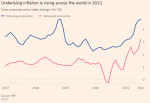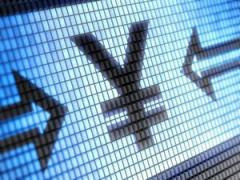The US dollar had one of its worst weeks in a few months. Although there has been some talk about the historical pattern of weakness after the first Fed hike in a cycle, many participants were surprised. The dollar struggled in the last couple of weeks of 2021, but this seemed to be explained by year-end position squaring amid light interest. Broad measures of US and European equities sold off last week. The pre-weekend recovery in the S&P 500 and NASDAQ could help lift offshore markets on Monday, but investors may be hesitant with the US on holiday. The Asia Pacific region fared best. The 2.4% gain of the MSCI Asia Pacific Index was led by Hong Kong, the Philippines, India, and Singapore. In the first two weeks of the year, the MSCI Emerging Markets Index has
Topics:
Marc Chandler considers the following as important: 4) FX Trends, 4.) Marc to Market, Featured, newsletter, USD
This could be interesting, too:
RIA Team writes The Importance of Emergency Funds in Retirement Planning
Nachrichten Ticker - www.finanzen.ch writes Gesetzesvorschlag in Arizona: Wird Bitcoin bald zur Staatsreserve?
Nachrichten Ticker - www.finanzen.ch writes So bewegen sich Bitcoin & Co. heute
Nachrichten Ticker - www.finanzen.ch writes Aktueller Marktbericht zu Bitcoin & Co.
 The US dollar had one of its worst weeks in a few months. Although there has been some talk about the historical pattern of weakness after the first Fed hike in a cycle, many participants were surprised. The dollar struggled in the last couple of weeks of 2021, but this seemed to be explained by year-end position squaring amid light interest.
The US dollar had one of its worst weeks in a few months. Although there has been some talk about the historical pattern of weakness after the first Fed hike in a cycle, many participants were surprised. The dollar struggled in the last couple of weeks of 2021, but this seemed to be explained by year-end position squaring amid light interest.
Broad measures of US and European equities sold off last week. The pre-weekend recovery in the S&P 500 and NASDAQ could help lift offshore markets on Monday, but investors may be hesitant with the US on holiday. The Asia Pacific region fared best. The 2.4% gain of the MSCI Asia Pacific Index was led by Hong Kong, the Philippines, India, and Singapore. In the first two weeks of the year, the MSCI Emerging Markets Index has risen (~2.5%), and its developed markets index has fallen (~-1.5%). The eight-basis point rise in the US 10-year yield reversed the earlier decline and it settled about 2.5 bp higher on the week. European yields were mostly lower.
The US 2–10-year yield curve flattened by eight basis points last week to about 82 bp and is about two basis point steeper than where it settled on Xmas eve. In contrast the German curve flattened by around one basis point last week and is about 11 basis points steeper since December 24.
While US price pressures accelerated, lockdowns in China, and other virus-related disruptions threatening more inflation, the 10-year breakeven fell-five basis points last week (to almost 2.47%) and around 12 bp since the end of last year. At 1.76%, the 10-year German breakeven is off about four basis points this year. On the other hand, the UK 10-year breakeven has risen eight basis points this year to 4.03%. It peaked last October around 4.25%. Japan’s breakeven has risen by almost 11 bp to 0.55%. It has not been higher since 2018.
Let’s look closer at the exchange rates:
Dollar Index: Even with the modest bounce ahead of the weekend, the Dollar Index posted its biggest weekly loss in four months (~0.60%). It fell below the uptrend line from early September in the middle of last week (~95.10). The trendline starts the new week near 95.20, just above the weekly close. Although the decline caught us wrongfooted, we suspect that it can recover in the coming days. The losses brought two technical objectives in to view. The first was the retracement of the last leg up that began around 93.30 in late October. The (61.8%) objective was by 94.65, which it narrowly took out on an intraday basis. The second was a double top (November 24 and December 15) near 96.95. The neckline was about 95.55, creating a measuring objective of 94.15. It settled two days below the lower Bollinger Band before edging back into it ahead of the weekend (94.90). The MACD is terribly overextended and the Slow Stochastic is becoming stretched.
Euro: The problem with short-term relationships is that they are short-term. The euro had appeared to be closely tracking the two-year German-US interest rate differential from early last September. The euro bottomed in late November as did the German discount. However, in the past two weeks, the German discount widened by about 18 bp to 1.54% and the euro rallied to its best level in two months. We did not expect an upside break of the $1.12-$1.14 range. Yet, with the outside down day ahead of the weekend (possible key reversal), the MACD at three-month highs, and the Slow Stochastic getting stretched, the euro looks technically vulnerable. After moving outside the Bollinger Band, it finished back within it (Upper band begins the new week near $1.1440). The continued threat of Russian hostilities in Europe, the shocking 0.5%-1.0% contraction in the German economy in Q4 (according to the official report), and a more volatile political situation (in Italy) continues to make us wary about chasing the euro.
Japanese Yen: The dollar rose from about JPY113.15 a couple days after the December 15 FOMC meeting to a high on January 4 around JPY116.35, a six-year high. It took place as the US 10-year yield rose from 1.35% to 1.80%. It looked like a breakout, but in the eight sessions since the high, the dollar has fallen in seven. It reached JPY113.50 before the weekend to meet the (38.2%) retracement of the rally since the Fed’s more hawkish turn in last September and test the lower Bollinger Band (~JPY113.45) The next retracement (50%) is near JPY112.75. The dollar reversed higher and set new session highs in the North American afternoon (~JPY114.25), and a possible hammer pattern was forged. The JPY114.60-JPY114.70 area may initial resistance. The momentum indicators are falling but are not stretched. The volatility of US equities appears to be loosening the relationship between the exchange rate and 10-year yields.
British Pound: Sterling rose for the fourth consecutive week for the first time since May. Over this run since Xmas eve, it has appreciated by about 2.15%. Only the Canadian dollar (2.10%) has been able to match it among the majors. Sterling managed to take out the 200-day moving average (~$1.3735) on an intraday basis last Thursday and Friday but could not close above it. The halfway mark of the sell-off from last year’s high (~$1.4250 on June 1) was met slightly above $1.3700. The (61.8%) retracement is around $1.3835, near those highs from the second half of October. After rallying more than a nickel in a month, it is not surprising that both momentum indicators are overextended. The MACD and Slow Stochastic appear poised to turn down. Initial support may be around $1.3600-$1.3615, but the (38.2%) retracement is by $1.3530.
Canadian Dollar: The greenback recorded its high for 2021 on December 20 against the Canadian dollar (~CAD1.2965). It has been under strong selling pressure since. It saw CAD1.2455 on January 13 before reversing higher, which left a bullish hammer candlestick in its wake. Follow-through dollar buying ahead of the weekend lifted it to around CAD1.2570. The next upside target is near CAD1.26, which you may recall is a neckline of a possible head and shoulders’ pattern that projects toward CAD1.2250. It is not unusual for the price action to come back and retest the neckline after the violation. There does not seem to be a rule of thumb of how far it can go back into the pattern to negate it, but a move above CAD1.2650 would begin being worrisome. The momentum indicators are overextended but will need follow-through US dollar gains to turn.
Australian Dollar: The 1% decline ahead of the weekend, pushed the Aussie down around 0.75% for the year, making it the weakest of the major currencies. The New Zealand dollar is off around 0.30% since the start of the year. They and the Swiss franc are the only major currencies not to have gained against the greenback over the past two weeks. The Australian dollar did poke above $0.7300 on January 13 for the first time since mid-November but could not hold it on a closing basis. It briefly slipped below $0.7200 before the weekend, giving back half of the rally from the previous week’s low (~$0.7130). The momentum indicators are pointing in opposite directions. A convincing break of $0.7200 target the $0.7130-$0.7150 area initially. The New Zealand dollar’s price action is similar. It approached $0.6900 on January 13, the high since late November sold off ahead of the week to almost $0.6790. It managed to close slightly above $0.6800. A break of the $0.6800 area may spur losses back to the $0.6700-$0.6730 area.
Mexican Peso: The dollar has been grinding lower against the peso. Marginal new lows have been registered for the past six sessions. The low ahead of the weekend was around MXN20.2820, just above the 200-day moving average (~MXN20.2780) and its weakest level since late October. The MACD has flatlined in oversold territory, while the Slow Stochastic is also overextended, but did not confirm the new lows. A close above MXN20.45 might be a signal of an impending greenback recovery. We note that Mexico’s 10-year dollar-denominated bond is selling off sharply. The yield has risen in nine of the past 10 sessions and has increased to 3.45% from 2.97%. The peso has appreciated about 1% over the past two weeks, while the JP Morgan Emerging Market Currency Index has risen by about 1.1%. Latam currencies account for half of the top 10 EM currencies at the start of the year. The Chilean peso leads the fx market with nearly a 4% gain against the dollar over the past two weeks. It fell almost 2.7% in December and 16.5% all last year. The newly elected president Boric is inheriting an economy (takes office on March 11) that grew 12% in 2021 driven by the fiscal stimulus and spending fueled by early pension withdrawals.
Chinese Yuan: A record trade-surplus and the broadly weaker US dollar challenged Chinese officials who have made it clear that it does not think further yuan strength is justified. The dollar tested the New Year’s Eve low near CNY6.34. It has not traded below there since May 2018. The greenback’s recovery before the weekend may help it hold above CNY6.35. State-owned banks (aren’t they all?) bought dollars in late mainland session, which seemed to underscore the official protests. On the margins, it may boost the chances that the PBOC cuts the rate of the one-year medium-term lending facility at the start of next week. The one- and five-year Loan Prime Rate is set early on January 20. These are ostensible market driven rates, and the five-basis point reduction of the shorter rate (to 3.80%) in December does not seem particularly meaningful. However, if it was allowed to fall again some may conclude it errored on the conservative side in December. Officials seem loath to admit mistakes. Still, if officials do not up their game, their street-cred will likely suffer.
Tags: #USD,Featured,newsletter








